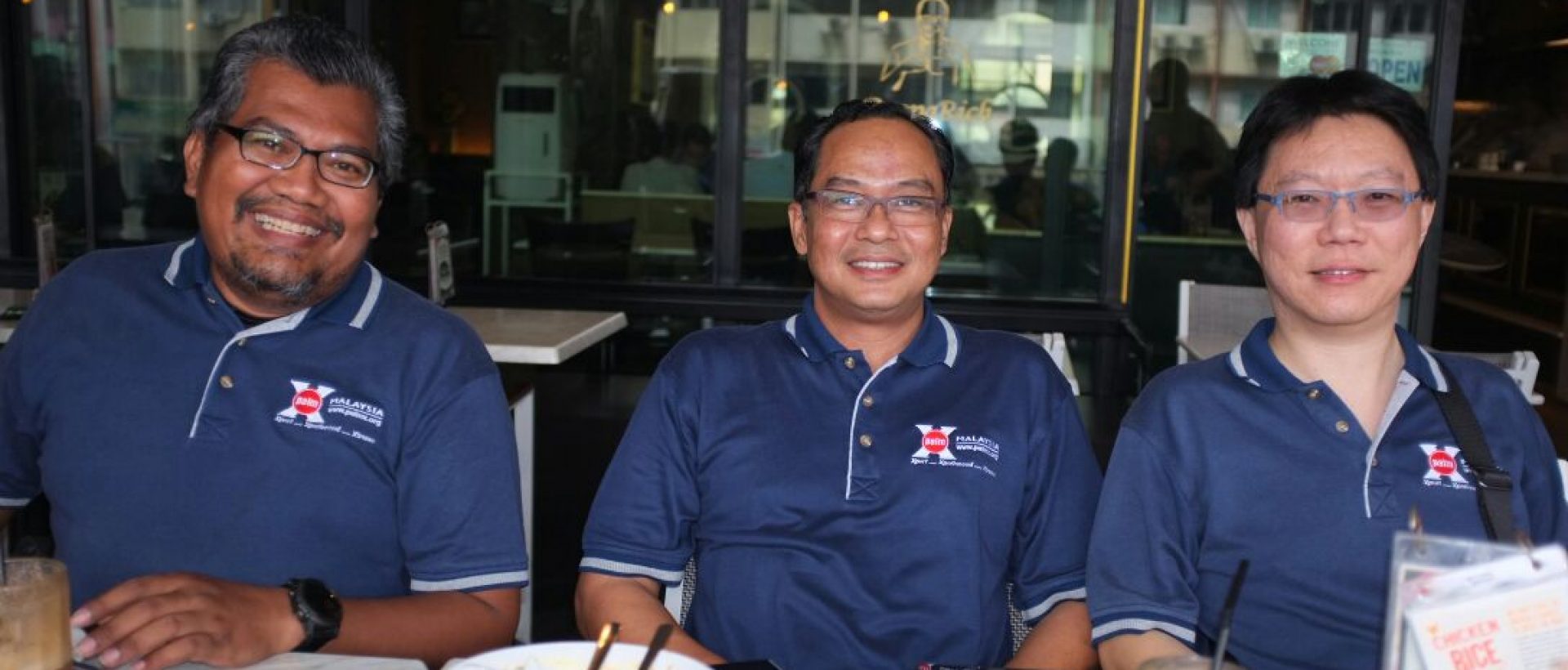In a belated attempt to control my body weight, I started cycling regularly since last Hari Raya Aidil Fitri. To obtain the maximum benefit from cycling, during cycling my target heart rate should be between 60-85% from my maximum heart rate. Since I am in my 40’s, roughly my maximum heart rate is 220 minus my age = 179 beats per minute (bpm), therefore my target heart rate should be between 107 till 152 bpm.
Being unfit and obese, I had to start slowly. For the first few weeks, I should aim for only 50% of my maximum heart rate. Over 3-4 months later, I should aim for 75% of my maximum heart rate. After 6 months, I should be able to comfortably cycle at the maximum heart rate of 85%.
But since I didn’t have a heart rate monitor (HRM), I had to make do with the subjective method of measuring my heart rate 😉
- If I can talk while cycling, it means that I am not getting enough exercise.
- Worse, if I can sing a song while cycling like in the Bujang Lapok movie, then the pace is too relaxed.
- If I am breathless until I had to step off my bike to push it, then I am cycling too hard.
However this subjective method is grossly inadequate. During my first group ride with Putrajaya Easy Riders (PERs) cycling group on Deepavali day in Putrajaya, we were riding on the Gemilang bridge towards Putrajaya International Convention Centre (PICC), circling the PICC and rode over the Gemilang bridge again towards the Putra Mosque. Since I was trying to catch up with a fellow rider, Dr Taufik, I huffed and puffed my way while climbing the PICC and over the Gemilang bridge. When I was at the peak of the Gemilang bridge, I started seeing “stars”. I had cycled too hard until my heart can’t cope anymore and my brain was not getting enough oxygen. Luckily I had enough sense to stop and recover, otherwise I might be swimming with the fishes instead :-p. Our guide for that day, Saifudin Ducati (his bike is Ducati and so is his apparel!), the owner of Nim’s Little Island Restaurant in Sg Ramal Dalam, guessed correctly that I was about to faint and advised me to rest and recover before continuing. Then I realised the need for an HRM to monitor my heart rate during cycling.
Thus began my search for a heart rate monitor, to ensure something like that doesn’t happen to me again in future rides. Some of the riders in PERs were using Polar HRM such as the F11 and CS-200. One of the members managed to get a Timex Zone Trainer Digital Heart Rate from a shop in Bangi for only RM399. When I tried getting a similar watch from a Time Galerie outlet in Mydin USJ, the salesgirl tried to sell it to me for RM599! Of course I said no.
Luckily for me, another fellow rider, Won Tzyy-ya bought for me the Cat Eye Dual Wireless Cyclometer & Heart Rate Monitor CC-HR200DW for around RM400 from a bike shop in Kuala Terengganu when he was there for the recent by-election. Thanks Won!
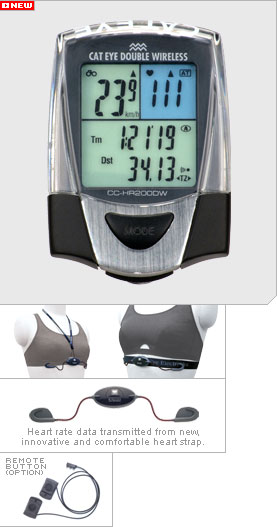
A picture of the cyclocomputer and the heart rate sensor.
Installation
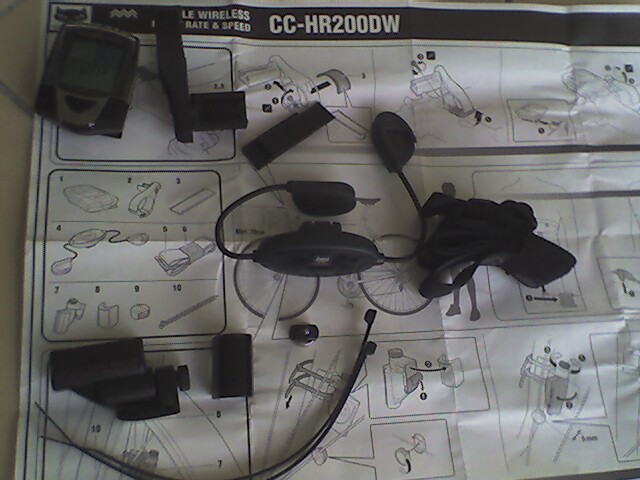 The components and the installation instruction pamphlet.
The components and the installation instruction pamphlet.
The installation was easy enough. First I installed the handlebar bracket on the handlebar (where else!).
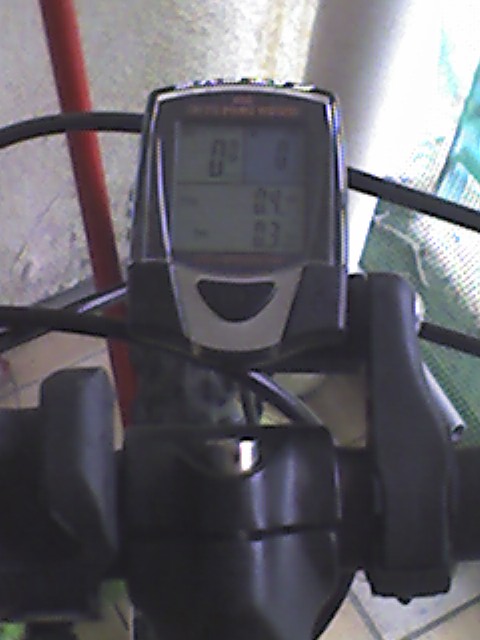 The handlebar bracket after installation.
The handlebar bracket after installation.
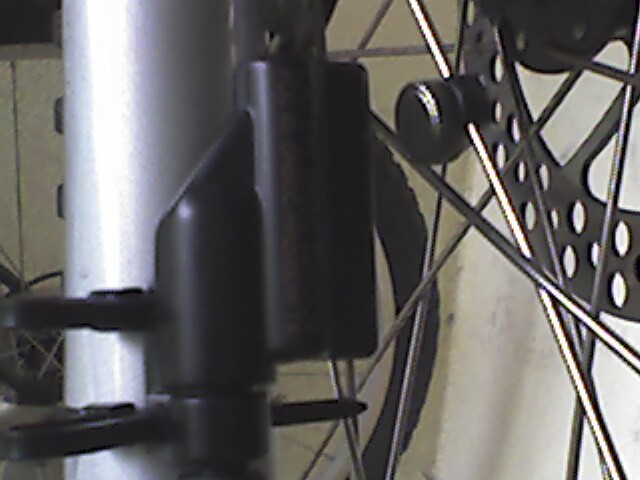 The speed sensor on the front fork (without the rubber base). The magnet should not be separated by more than 5 mm from the speed sensor.
The speed sensor on the front fork (without the rubber base). The magnet should not be separated by more than 5 mm from the speed sensor.
Then I installed the speed sensor onto the front fork using the two cable ties. Despite perusing the manual, I still managed to make one mistake, I didn’t install the rubber base for the speed sensor during the first attempt. Instead I had installed the speed sensor directly onto the fork. I had to remove the cable ties to redo it again. Then I screwed the magnet onto one the front wheel spoke, at a position that allows the face of the magnet to face the sensor zone, ensuring that the distance between the speed sensor and the magnet was not more than 5mm at its closest point.
Then I rotate the front wheels to check whether the speed sensor is detecting the wheel movement and transmitting the signals correctly to the cyclocomputer. Since I can see the speed of the rotation being displayed on the screen of the cyclocomputer, Voila! its done. If not adjust the postion of the magnet and the sensor.
Configuration
Resetting the cyclocomputer
This part was easy. I just press the MENU and the RESTART button simultaneously, and then release the RESTART button first, followed by the MENU button.
Configuring the Cyclocomputer
After formatting, the screen moves to the “Selecting the measuring unit” screen. Use the Mode-1 or the Mode-2 button to choose between km/h or mph (miles per hour). Press the START/ENTER button to select the unit.
This is followed by the tire circumference screen. Use the Mode-1 or the Mode-2 button to choose between A or B. The default for A is 2096, which is the usual standard wheel circumference for a road bike (RB) (700 x 23C). The default for B is 2050, which is the usual standard wheel circumference for a mountain bike (MTB) (26 x 1.95). Since I was installing it on my Proton T-Bolt MTB, I chosed B.
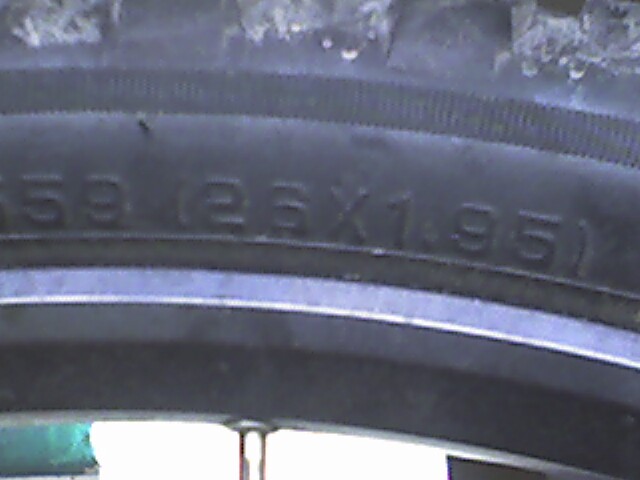
Tyre size of 26 x 1.95 therefore the wheel circumference is 2050.
If you have two different bikes (or as we say in PERs; “polygamy” ;-)), you can use the A setting for your RB and the B setting for your MTB. You can purchase the necessary parts (HR200DW parts kit – handlebar bracket, speed sensor, and wheel magnet) to install on the second bike by contacting;
Gin Huat Cycle Trading Sdn.Bhd.
31, Jln Tiaj 2/5, Tmn Industri Alam Jaya,
Bukit Cherakah, 42300 Bandar Puncak Alam, Selangor.
Tel: 03-6038 3703
Fax: 03-6038 3702 / 5550
You can change the wheel circumference if necessary on the next screen. A tyre circumference chart is provided in the userguide to help you make the correct choice.
Next is the Heart Rate Zone screen. Please enter your lower and upper target limits. You can refer to the provided chart and method of calculation in the CC-HR200DW userguide. I relied on the guide given on the American Heart Association website instead. Based on their calculations, my target heart rate should be between 107 till 152 bpm.
The instruction on how to determine your target heart rate inside the CC-HR200DW userguide.
To obtain your target zone, see the table below, which illustrates the correlation between heart rate and training level. 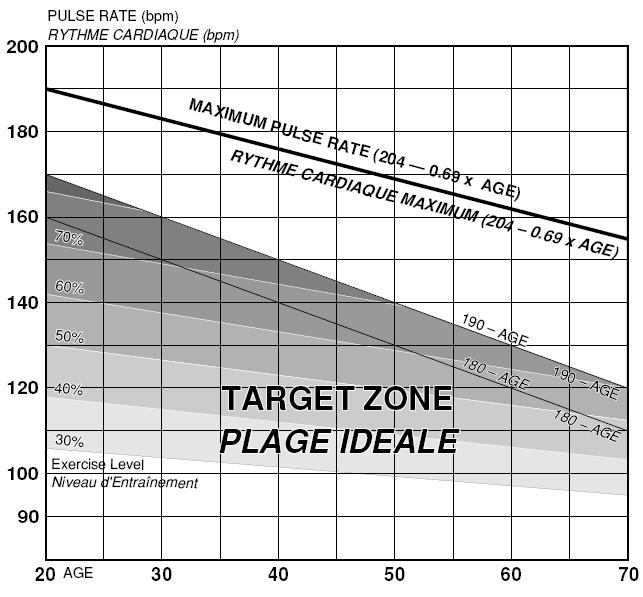 For beginners, it is recommended to start with the level of 30% of your max. From this point, gradually increase the level according to your fitness level and experience. Training at levels over 70% of your HR max will focus more on anaerobic exercise, and less on aerobic exercise. Weight loss usually occurs through longer rides (over 1 hour) at lower HR levels. For beginners, it is recommended to start with the level of 30% of your max. From this point, gradually increase the level according to your fitness level and experience. Training at levels over 70% of your HR max will focus more on anaerobic exercise, and less on aerobic exercise. Weight loss usually occurs through longer rides (over 1 hour) at lower HR levels. |
Configure the rest (time, odometer, sound etc) accordingly. Once done click on the MENU button to save your changes.
Using the CC-HR200DW
I have used the CC-HR200DW many times already. It measures the following;
- Current, Average, and Maximum speed
- Current, Average, and Maximum heart rate
- Elapsed time
- Total time
- Clock
- Trip distance
- Odometer
- Calorie consumption – how accurate is this? It stated that for my 14km ride at FRIM, I used up 1,200 kcal. Does it take my weight into account?
The speed sensor performs as it should, no complaints there. My only problem is with the heart rate sensor. It is not performing as well as it should be. Below is a table of my feedback on the HR sensor;
| Date | Comment |
| 31/1/09 | Putrajaya ride 29km – Heart rate sensor inconsistent. Sometimes 0, sometimes 70, sometimes recording properly. Avg 95, Max 175. |
| 2/2/09 | FRIM 11km – Again inconsistent but not as bad as earlier. Sometimes it displays 70 instead of the correct HR. Avg 119, Max 169. |
| 7/2/09 | FRIM 14km – No problem whatsoever. Avg 98, Max 176, |
| 8/2/09 | South GCE 20km – Heart rate sensor inconsistent. Sometimes 0, sometimes 70, sometimes recording properly. Avg 98, Max 145. |
| 15/2/09 | GCE 44km – Heart rate sensor totally kaput. Only starts working after the ride. |
Works properly only once out of 5 times. I went through the userguide to solve the issues and it gave some troubleshooting tips. Examples of some of the tips given;
Heart rate signals are not received.
Has the rubber surface of the electrode pad come off? No
Dry skin (particularly in winter) – No
Is the battery for the heart rate sensor used up? – No, already replaced with new one, just in case.
Fluctuation in the heart rate indicator, for example it returns to zero and then the heart rate is measured again.
Is the electrode pad being worn correctly? Yes
So no luck there. I bought some KY Jelly recently from a pharmacy. Hopefully the better contact will improve the function of the HR sensor.
Being a double wireless model, it is highly susceptible to interference. The HR sensor signals wont be received by the main unit if you are near a running vehicle, near a computer or near an internet wireless access point/router. The main unit data also could be corrupted if brought into a car with the engine running, near a handphone and near a computer. For example when I was trying to SMS my distance, average/maximum speed/heart rate to another doctor, the maximum speed changed from 46 km/h to 118 km/h when I put the main unit near the handphone. After cycling, I have to jot down my data somewhere since if I bring it into the car, the data will be corrupted.
The other problem was with the main unit being unable to go into sleep mode after use. So I had to manually put it into sleep mode using this method;
To put into Sleep mode;
- Go to the Max Speed page.
- Press “Mode 1” button, don’t let go.
- Press the Start button, don’t let go.
- Keep pressing until the screen displays “SLEEP”.
I also had some trouble resetting the distance and time back to zero after using it. I can’t use the restart button since I would’ve to reset the clock. Later I discovered this method by accident;
To reset measurement;
- Press Mode1 button, don’t let go.
- Press the Start button, don’t let go.
- Let go Mode1 button.
- Let go Start button.
Another major weakness of CC-HR200DW is that there is no option for cadence measurement. Cadence is the number of revolutions of the crank per minute; roughly speaking, this is the speed at which a cyclist is pedalling (not the speed of the bike). For serious cyclist who wants to maintain their cadence at a certain rate i.e. 80 rpm, they can’t use the CC-HR200DW. Instead the newer models such as Cateye CC-TR300TW Triple Wireless Cadence and Heart Rate Bicycle Computer has such functions.
Conclusion
At only RM400 for a double wireless function, it seems like a good buy initially. But heart rate measurement is not one of Cat Eye’s strong point as you can see above. If you check out the CC-HR200DW customers review at the Amazon’s website, they all faced similar problems. Therefore if heart rate measurement is a priority, then any of the Polar models would be a better choice. For an extra RM150, you can get a Polar CS200cad which not only provides similar functions but also measures the cadence of the cyclist.
